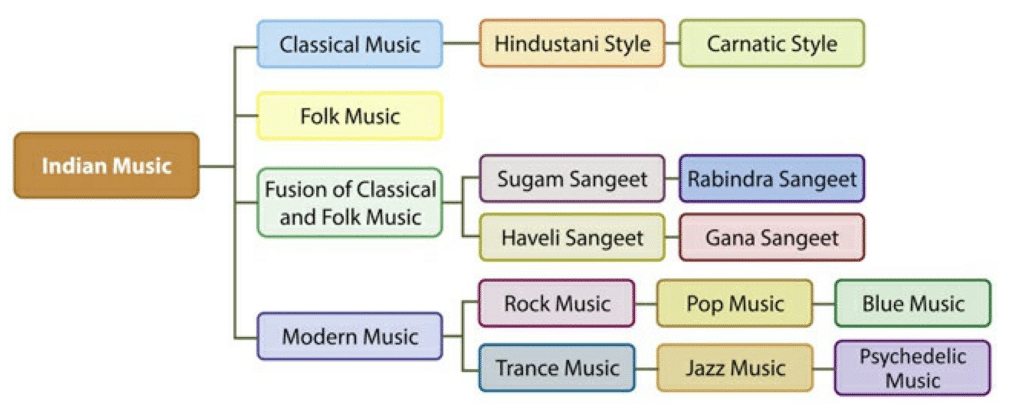Introduction
Imagine music that doesn’t just sound beautiful but seems to whisper directly to your soul. Indian classical music is not just about melody or rhythm—it is a sophisticated system of emotional storytelling. Each raga, a melodic framework, is designed to evoke a particular mood or state of mind. Where Western music often leans on scales and harmonies, Indian classical music thrives on nuance, improvisation, and the ability to tap into our deepest emotions.

But how exactly do ragas affect our minds? And can modern neuroscience explain why listeners across centuries have described them as calming, energizing, or even transformative? Let’s take a journey through the science, psychology, and poetry of this ancient tradition.
Dig Deeper: Listen to Indian Classical Music
The Rasa Connection
The foundation of Indian classical music lies in the aesthetic theory of rasa, meaning “essence” or “flavor.” In classical Indian arts, rasa refers to the specific emotional response that art should evoke in its audience. Ancient texts such as Bharata’s Natyashastra outlined nine core rasas—love, laughter, sorrow, anger, heroism, fear, disgust, wonder, and peace. Musicians have historically used ragas as vehicles to express and evoke these states (Choubey & Sharma, 2015).
For example, Raga Bageshri is traditionally performed late at night to evoke feelings of longing and devotion. Raga Bhairav, performed at dawn, is often associated with solemnity and reverence. This time-specific tradition is not arbitrary; it reflects centuries of empirical observation about how sound, time, and mood intertwine.

Neuroscience Meets Tradition
Modern research is beginning to catch up with what performers and listeners have known for centuries: ragas have measurable effects on the brain and body.
Distinct Emotions from Raga Structure
Mathur et al. (2015) conducted a study in which listeners rated emotions evoked by ragas presented in two modes: alaap (slow, rhythm-free) and gat (faster, rhythm-bound). They found that alaap performances often elicited calmness or sadness, while gat performances generated feelings of happiness, excitement, or tension. Tempo and rhythm influenced arousal, while melodic intervals influenced emotional valence. Major intervals tended to evoke positive emotions, whereas minor intervals leaned toward negative ones.
Brainwave Harmony
Electroencephalography (EEG) studies have shown that listening to Indian ragas can increase alpha brainwave activity, which is associated with relaxed, meditative states (Kunikullaya et al., 2022). Some ragas even influence attention and arousal levels, pointing to their potential use in cognitive therapy and concentration enhancement.
Physiological Benefits
In a clinical intervention, participants listened daily to Raga Desi-Todi for 20 days. Results showed significant reductions in blood pressure, anxiety, and depression, along with increases in hope and life satisfaction—particularly in women (Gupta & Gupta, 2005). This suggests that ragas are not just pleasant—they can be powerful tools for psychological well-being.
Visualizing Emotion
To better understand how ragas work, think of their components as ingredients in a recipe:
- Tonality (intervals): The emotional “colors.” Major intervals feel bright and uplifting; minor intervals feel somber or introspective.
- Tempo and Rhythm: The “volume dial” of energy. A slow, flowing tempo relaxes the mind, while a fast-paced rhythm stimulates excitement and arousal.
Together, these elements create what might be called “soundscapes of emotion.”
When the Raga Speaks
Consider this: it is dawn, and a sitarist begins playing Raga Bhairav. The low, heavy notes immediately create an atmosphere of solemnity. The listener feels calm, reflective, even spiritual—exactly the effect intended. Contrast this with Raga Yaman, an evening raga, whose bright, expansive notes open the mind to feelings of romance and devotion.
-min.jpg)
This time-of-day specificity makes Indian classical music unique in its relationship between environment and psychology. The “when” of performance is as important as the “what.”
Digital Therapy and Personalized Learning
Where does this lead us in today’s fast-paced world?
- Targeted Music Therapy: Specific ragas may be prescribed for stress, depression, or insomnia, much like medication but without side effects.
- Personalized Playlists: Imagine an app that selects ragas tailored to your mood, time of day, and mental health needs—a 21st-century adaptation of an ancient practice.
- Creative Neuroscience: Further studies are mapping how improvisation affects performer cognition. EEG studies of musicians mentally performing ragas reveal patterns of creativity that overlap with problem-solving and flow states (Tripathi & Singh, 2017).
Conclusion
Indian classical music shows us that art and science are not opposites but partners. Ragas are both ancient emotional codes and modern psychological interventions. From regulating stress to deepening creativity, they stand at the crossroads of tradition and neuroscience.
So next time you hear a sitar or flute weaving a raga, remember: it’s not just music—it’s a conversation with your brain, your emotions, and maybe even your soul.
References
Choubey, S., & Sharma, K. (2015). Rasa theory and Indian classical music: An analysis of aesthetic emotion. Journal of Arts and Aesthetics, 3(2), 45–58.
Gupta, U., & Gupta, B. S. (2005). Psychophysiological responsivity to Indian instrumental music. Psychology of Music, 33(4), 363–372. https://doi.org/10.1177/0305735605056142
Kunikullaya, K. U., Goturu, J., Muradi, V., Hukkeri, P. A., Doreswamy, V., & Sharma, P. (2022). Effect of Indian classical music on the brain: A review of EEG studies. International Journal of Neuroscience, 132(2), 123–134. https://doi.org/10.1080/00207454.2021.1886249
Mathur, A., Vijayakumar, S. H., Chakrabarti, B., Singh, N. C., & Chakrabarti, B. (2015). Emotional responses to Hindustani raga music: The role of tempo, rhythmic pattern, and tonal complexity. Frontiers in Psychology, 6, 513. https://doi.org/10.3389/fpsyg.2015.00513
Tripathi, S., & Singh, R. (2017). Neural correlates of creative cognition during raga improvisation: An EEG study. Cognitive Neurodynamics, 11(6), 557–567. https://doi.org/10.1007/s11571-017-9441-8
Subscribe to PsychUniverse
Get the latest updates and insights.
Join 3,005 other subscribers!
Niwlikar, B. A. (2025, September 2). The Psychology of Indian Classical Music and 4 Important Ways that Neuroscience Meets Tradition. PsychUniverse. https://psychuniverse.com/psychology-of-indian-classical-music/



